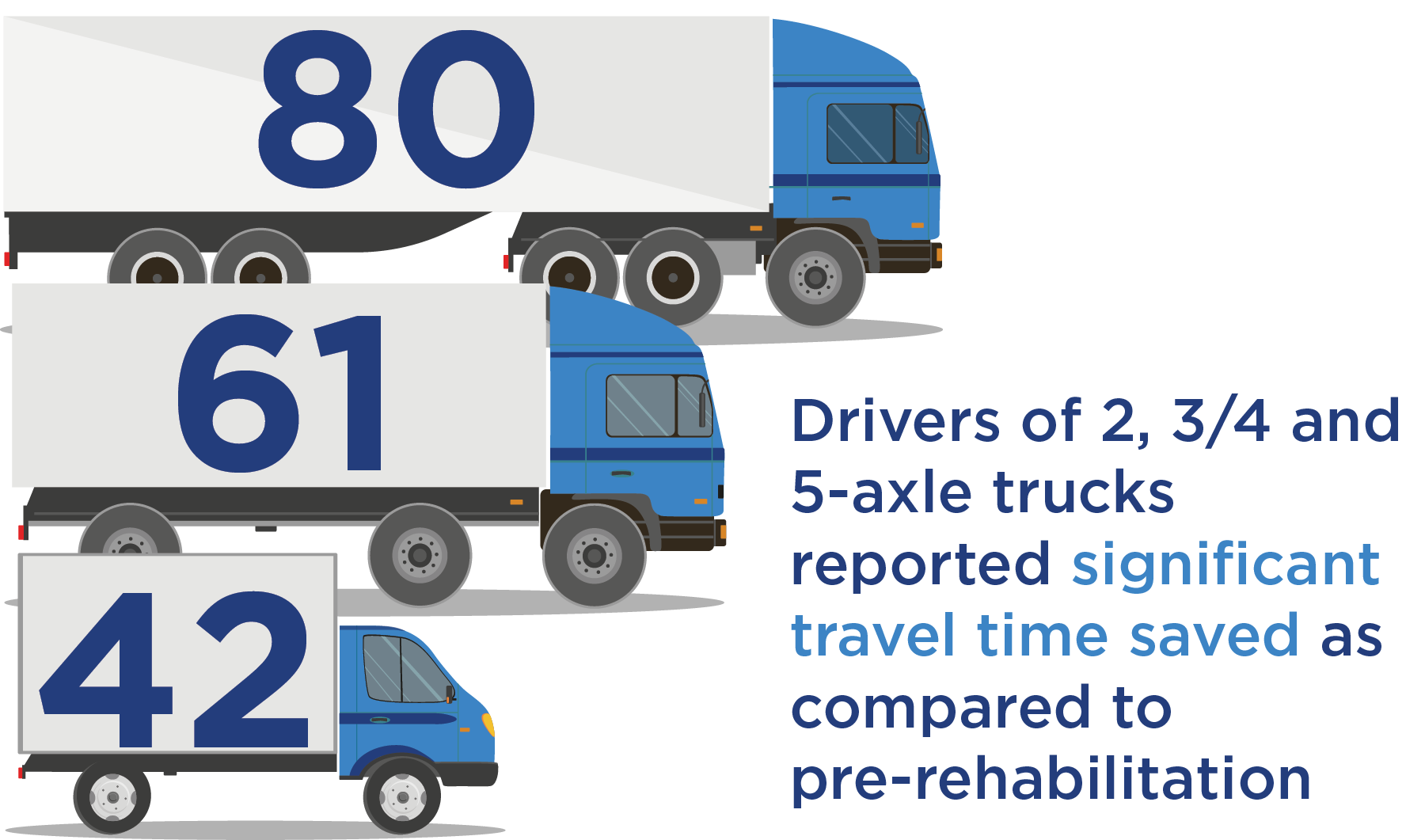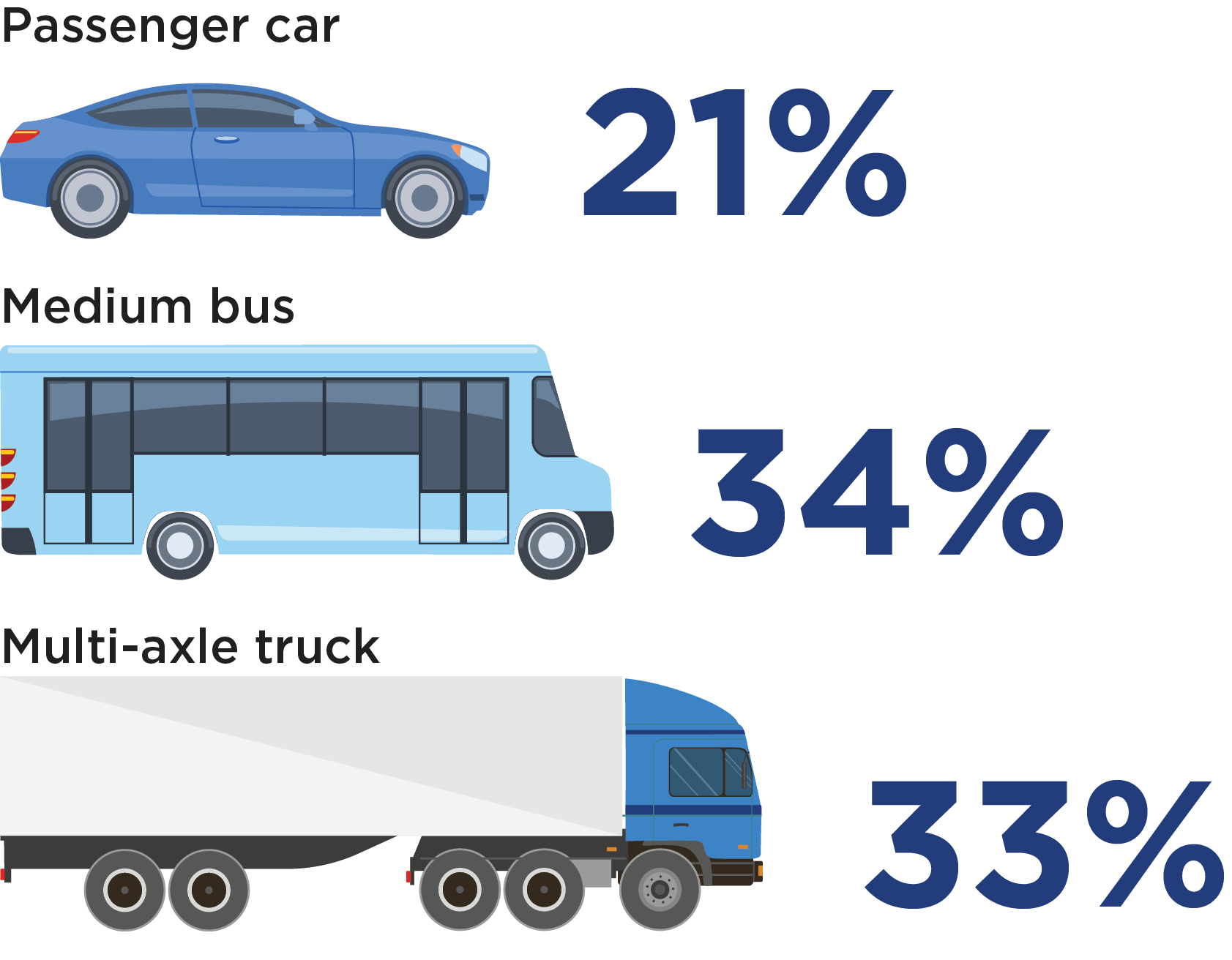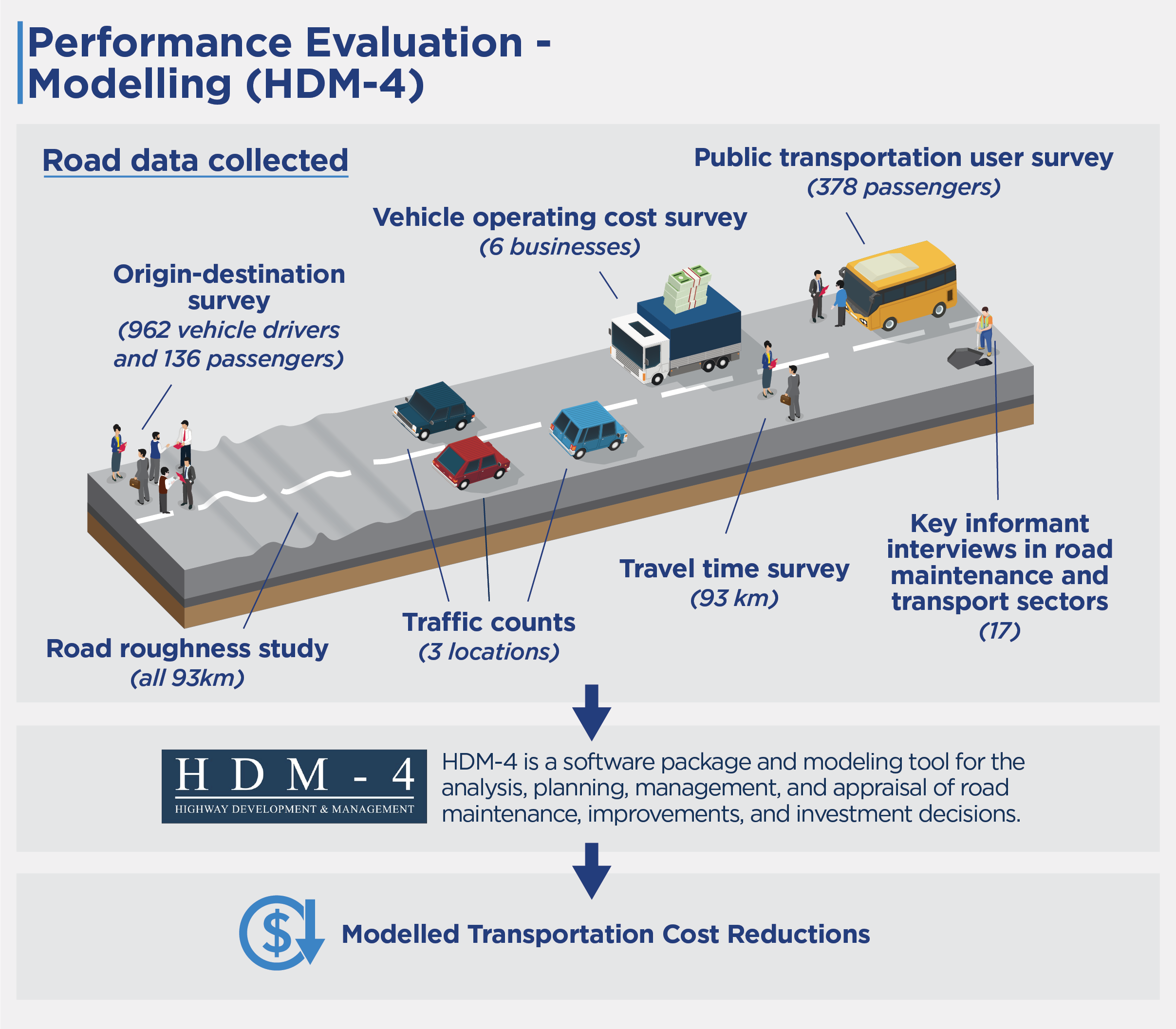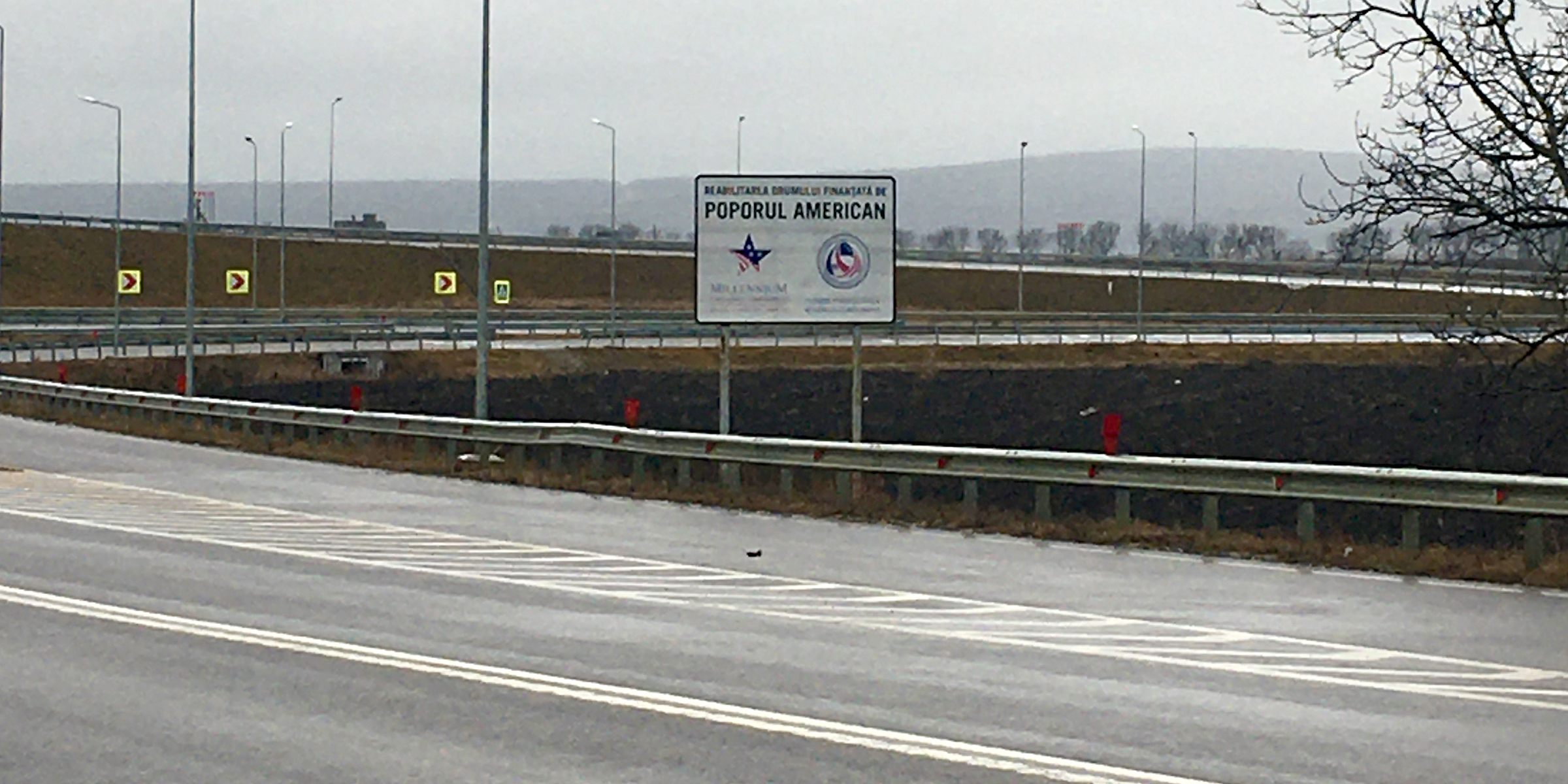Program Overview
MCC’s $259 million Moldova Compact (2010-2015) funded the $109.7 million Road Rehabilitation Project to rehabilitate and upgrade a 93 kilometer portion of the national M2 Road. The project also replaced and upgraded associated structures within this segment of the M2, such as bridges, drainage systems, and culverts. By rehabilitating a deteriorated portion of the M2 Road and increasing the quality of Moldova’s road network, MCC aimed to reduce transportation costs, enhance road safety, and improve economic outcomes.
Download the Romanian translated evaluation brief.
Key Findings
Project Implementation
- The project was completed ahead of schedule, rebuilding 96 kilometers of road (more than the planned 93 kilometers) and coming in $23 million under budget due to new building techniques.
Road Maintenance
- The M2 Road is a high-quality road that has been well-maintained seven years after the project’s completion.
- However, allocations to the Road Fund for maintenance of the entire road network have not met expectations.
Road Users and Patterns
- Average daily traffic on the M2 Road in 2022 was approximately 4,475 vehicles, which transport more than 11,000 road users daily.
- The rehabilitated road has significantly reduced travel time.
- Accidents, injuries, and fatalities have all decreased since the road was rehabilitated and made safer.
Transportation Market
- There was a 20-34% reduction in vehicle operating costs. Private vehicle users receive the benefits of costs savings.
- Public transportation is highly regulated with bus fares that do not cover the cost of operation, so savings in vehicle operating costs were not passed on to consumers.
Evaluation Questions
This final performance evaluation was designed to answer the following questions:
- 1
Were there any deviations from the original project design? - 2
What is the likelihood that MCC’s investment will remain adequately maintained? - 1
Have road usage patterns changed? - 2
What portion of vehicle operating cost savings will be passed on to consumers of transportation services?
Detailed Findings
Project Implementation

Map of M2/R7 Road
With MCC’s investment, the rehabilitation works improved the M2 Road connecting Sarateni, northwest of Chisinau, to Soroca, at the northern border with Ukraine. The project surpassed its original target of 93 kilometers, by rehabilitating more than 96 kilometers of road by the end of the project. Road improvements included safety features designed to slow traffic and reduce accidents. The project had cost savings of approximately $23 million. The cost reduction was achieved through the adoption of a cold asphalt recycling technology, as recycling parts of the old pavement helped reduce the use of new materials.
Road Maintenance
As a requirement before the road rehabilitation would begin, the Government of Moldova had to amend the Road Fund to automatically allocate a portion of the excise tax on fuel towards road maintenance. The Road Fund was amended and fully funded from 2010 to 2014. However, recent allocations have been lower than the expected 80% at approximately 50-60% of the fuel excise tax due to various economic and political crises in Moldova.
Despite this, the M2 Road is in very good condition. The road has been well maintained with an International Roughness Index between 1.08 and 1.27 meters per kilometer, seven years after the rehabilitation. There is a high likelihood that this practice will remain for the life of the investment because of the observed maintenance practices of the State Road Authority and through confirmations received from road maintenance firms about maintenance contracts.
Road Users and Patterns
The average daily traffic on the M2 Road was estimated at 4,475 vehicles in 2022 versus approximately 2,818 vehicles in 2009. More than 11,000 road users, including drivers and passengers, travel on the M2 Road on a given day. Most of the drivers of vehicles transporting goods or passengers are male and the average age of all adult road users is 43 years old.
The composition of traffic changed significantly between 2009 and 2022. In 2009, approximately 12.4 percent of vehicles were trucks, but by 2022 their share had risen to 28.2 percent. On the other hand, the share of buses traveling on the M2 had fallen from 23.5 percent to just 6.3 percent. The share of light vehicles (cars, SUVs, jeeps, vans) was virtually unchanged.

Travel time saved, in minutes, per truck type
The M2 Road is almost exclusively used for local travel within the northern region of Moldova. The main purpose of travel is work-related, followed by visiting family members. Approximately 75% of all goods being moved on the M2 Road are foodstuffs, produce, and construction material.
Time savings have been significant. Compared with before the project, truck drivers report that their trips are now almost one hour shorter and 91% of bus passengers reported that the rehabilitated road had reduced travel time. Even with more vehicles and faster travel times, the number of accidents on the road has fallen by 39%, injuries by 27%, and fatalities by 10%.

Vehicle operating cost savings, per vehicle type, calculated from HDM-4 model
Transportation Market
Vehicle operating cost savings have accrued to vehicle owners. Public transport users did not see a reduction in fares since bus fares are set by the Ministry of Transport and Roads Infrastructure. Freight transporters indicated freight rates vary depending on the competition and competition is high since goods’ transport prices are not regulated but instead negotiated between transporters and clients.
Economic Rate of Return
MCC considers a 10 percent economic rate of return (ERR) as the threshold to proceed with investment.
- 21.1%
Original ERR - 25.2%
Evaluation-Based ERR
Drivers of deviation from the original ERR include: higher proportion of heavy vehicles (+); lower increase in overall volume of traffic (-); slower road deterioration (+); lower construction costs (+); and higher estimated value of time saved by road users (+).
MCC Learning
MCC should consider recycling old road pavement to reduce costs.
Roads should be designed to be more durable to require less maintenance.
Safety features can successfully be incorporated into road design.
Rigorous calibration of technical equipment for data collection provides confidence in evaluation results.
Evaluation Methods

This performance evaluation used modelling (HDM-4), pre-post, and ex-post methodologies, supported by quantitative and qualitative data collection. The exposure period was 83-84 months (about 7 years).
Quantitative data collection occurred from September to November of 2022 and it included traffic counts (three locations) conducted over three days (two weekdays and one weekend); an origin-destination survey of 962 vehicle drivers and 136 passengers conducted over 24 hours; a public transportation user survey of 378 passengers conducted over one day; a vehicle operating cost survey of six businesses; a road roughness study of the 93 km; and a travel time survey. Qualitative data collection included 17 key informant interviews with stakeholders in the road maintenance and transport sectors. Secondary administrative data on fuel usage, rail fares, and maintenance budgets were also used.
2023-002-2857


